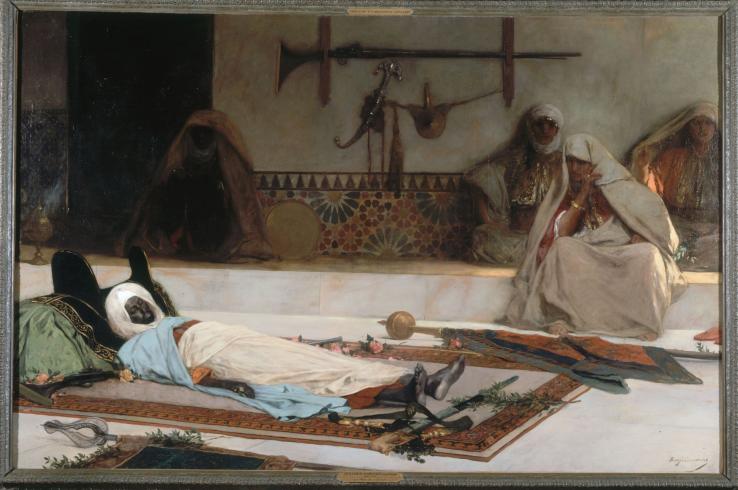This large Oriental composition presented at the French Artists’ Salon in 1889 entered the Petit Palais collections in 1905. The work takes us into a Moroccan house on the day of a funeral wake. Restored with its original frame in 2014, thanks to the support of the museums of Toulouse and Montreal, it was recently returned to its place in the City of Paris Musée des Beaux-Arts, in the garden-level gallery dedicated to the 19th century. Its return follows the loan of the painting for the retrospective exhibition “Benjamin-Constant, marvels and mirages of Orientalism”, organised by the Toulouse Musée des Augustins and the Musée des Beaux-Arts in Montreal.
As a key figure of the Orientalism movement popular during the French Third Republic, Benjamin-Constant was hailed during his life both for his ambitious compositions on historical subjects and his talents as a portrait artist, which were particularly appreciated by American clients. He received commissions for decorative paintings for prestigious locations such as the Opéra-Comique, the Sorbonne, Paris City Hall, and the Capitole in Toulouse.
Created more than twenty years after the painter’s stay in Fez, this work in the Petit Palais beautifully demonstrates Benjamin-Constant’s Orientalist imagination. The artist depicted his memories of Morocco with great skill. The composition is arranged in a series of horizontal planes. In the foreground, the body is laid on the floor surrounded by flags on a rich Oriental rug which is scattered with roses and olive branches. A deathly expression can be discerned on his still young face (with Ethiopian or sub-Saharan features). The head is resting on a saddle with a high cantle and pommel, typical of those used by North African horsemen. His slim body enveloped in a white burnoose is lavishly covered with subtly coloured fabrics. On his hand is a precious ring and a gold ring indicating the importance of this anonymous dignitary.
The upper part of the painting is occupied by women who are watching over the body. The group on the right is composed of three richly attired women, of Arab or Berber origin. They are making gestures – portrayed by the sense of movement of their hijabs and sleeves - which seem to bring them to life. The group is lit up from the right with the warm tones of sunset. On the left, hidden in the shadows, is a woman of African origin whose features are barely visible, and who seems to be filled with even greater sorrow. On the far left of the painting, not far from the head of the deceased, faint wafts of smoke drift away from a perfume burner. The white marble floor is extended by a large light-coloured wall, its lower part decorated with ceramic tiles with a geometric floral motif, inspired by the Alhambra.
To make the composition appear more real, the painter paid particular attention to the portrayal of ceremonial funeral objects. The artist’s Parisian studio was richly decorated with a large collection of rugs, fabric, items of woodwork and other objects from North Africa which he used as models for his paintings. The weapons surrounding the deceased are accurately depicted. The long flintlock rifle, the large dagger with a finely decorated curved blade and the powder flask suspended on the wall underline the status of the master of the house. The composition as a whole exudes an atmosphere of calm and silence, accentuated by the subdued décor. In this later work, Benjamin-Constant abandoned the violence and eroticism seen in the compositions which made him popular. The funeral theme addressed here, in a register of sober gravity, provides the viewer with an ethnographic reality which is fairly accurate in its depiction of ethnic types, objects, costumes and attitudes. As well as its unabashed exoticism, the work confronts us with the universal experience of death.
The painting, which had remained in the studio after its exhibition at the Salon, marks the end of Benjamin-Constant's large Oriental compositions. As if to erase the memory of its relative failure at the Salon (the painting neither won an award nor was sold), the artist slightly altered the composition by replacing the window in the background with a black curtain. Restoration work revealed, at bottom right, the date of 1889 which had been hidden by repainting. The restored work was admitted to the museum with a new title: “The Death of the Emir”.
I. C. and R. Z.
Bibliography: Note written by Dominique Lobstein in the catalogue Benjamin-Constant (1845-1902), Marvels and Mirages of Orientalism, Paris, Editions Hazan, 2014, p.208-211.

City of Paris municipal collection's website
The collections portal can be used to search the collections of Paris’s 14 municipal museums (approximately 336,000 works, including 43,000 belonging to the Petit Palais).
It is also possible to download around 12,000 images of the museum’s works free of charge.
Access the Museums of the City of Paris collections portal
Extern databases
Discover a selection of databases online presenting works from the Petit Palais or documents concerning the history of the museum.

